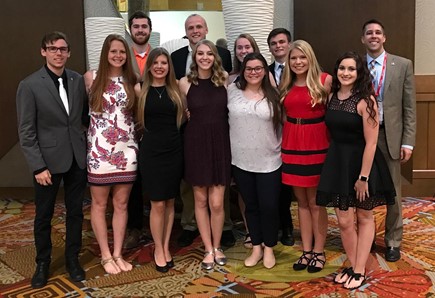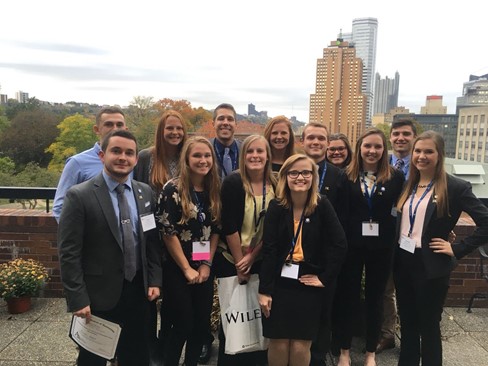Member Shares His Zeal for Anatomy With Students, Invents New Lab Designs
By Sheryll Poe
This article was originally published in the May 5, 2021 edition of the Anatomy Now newsletter.
 If you’ve attended an AAA Annual Meeting at the Experimental Biology Conference in the last 10 years, chances are you’ve seen Matthew J. Zdilla. Or, you’ve definitely met and heard from one of the many students that he has brought to the meeting.
If you’ve attended an AAA Annual Meeting at the Experimental Biology Conference in the last 10 years, chances are you’ve seen Matthew J. Zdilla. Or, you’ve definitely met and heard from one of the many students that he has brought to the meeting.
That’s because Zdilla has brought approximately 100 students to the AAA Annual Meeting over the last decade, with over 250 presentations featuring student authors. In 2019, his team of 11 students from West Liberty University had 25 presentations alone. “I’ll bring a dozen at a time,” said Zdilla, an Associate Professor in the Department of Pathology, Anatomy, and Laboratory Medicine.
Zdilla’s passion for exposing his students to the scientific community came from his own experience attending a chemistry conference as an undergrad at the University of Pittsburgh. “It was one of the best experiences I ever had,” he remembered. “It blew my mind seeing all these scientists and people communicating with each other, and it’s contagious.”
Zdilla admits he wouldn’t be able to get as many of his students involved in EB without AAA’s financial support. “AAA gets a lot of credit with the student travel awards,” he added. “That helps with their costs and they always have awesome experiences with everyone. They see that scientists are fun and passionate.”
His primary objective—beyond building a passion for science—is to get the students involved with projects that will be published, “so they see what they’re doing is having an effect and they get passionate about it, and get them pumped about research.”
What started as a handful of students from West Liberty University has grown to “a flock of students” over the years, Zdilla said. “One of my favorite moments as a professor is at an AAA meeting--and there were a bunch of us-- and the students took me around to every poster and wanted a picture with me and their poster.”

Focusing on the Health Care Side of Anatomy
Zdilla’s route to anatomy professor was a bit unconventional. “I went to chiropractic college, and that is not very common for anatomists,” he laughed. “It’s actually a natural fit. We tend to have more medical training than some of our counterparts, in terms of imaging and patient care.”
His brother was also a chiropractor and a professor of anatomy, so Zdilla soon followed as an adjunct professor in addition to working at his chiropractic practice. “I tried to do both, but it came to a point where I had to make a decision,” he said. “And it fell in line with what I want to do, my goal is to help people and prevent health problems, which is still my focus.”
After several years at West Liberty University, Zdilla transitioned to West Virginia University in June. “The big exciting thing about WVU is that they have a dental and a medical school and these are student populations I was really interested in working with,” Zdilla added. “I was also excited because WVU is associated with a hospital, so collaboration is off the charts on the clinical side of things.”
Building a Better, More Accessible Lab
In addition to his teaching duties, Zdilla is a tinkerer who is dedicated to coming up with cost-effective ways for other schools and universities to create their own gross anatomy laboratories. “When I interviewed at West Liberty, I said I’d love to have a gross anatomy lab here. But it’s a small school and a lot of those schools can’t afford to build that kind of lab,” Zdilla noted. “I made it a goal of mine to build a lab and I did.”
Using an old chemistry lab, Zdilla created a ventilation system using inline duct fans attached to the downdraft table, instead of the traditional and more expensive laboratory vent hood. “Inline duct fans boost air flow and you can attach a fan to the tube. I got one and it boosted the ventilation enough to have an operating table and we could have a cadaver lab,” he explained. His findings and designs were published in “Anatomical Science Education.”
More recently, he designed and built a downdraft table using materials found in any home improvement store at a cost of approximately $200. A traditional table costs $7,000. His design for an inexpensive yet effective downdraft table has been submitted to “Morphologie” for publication. “A new goal of mine is to spread accessibility to gross anatomy everywhere,” Zdilla said.
It would be difficult to put any anatomist in a specific category or box, that is certainly true with Zdilla. “I love anatomy and love helping people and that’s what the research is all about. It blends all those things together. So when someone asks: ‘What does this guy study?’ My answer is, ‘People, I guess,’” he laughed. “I’m not pigeonholed as an anatomist.”